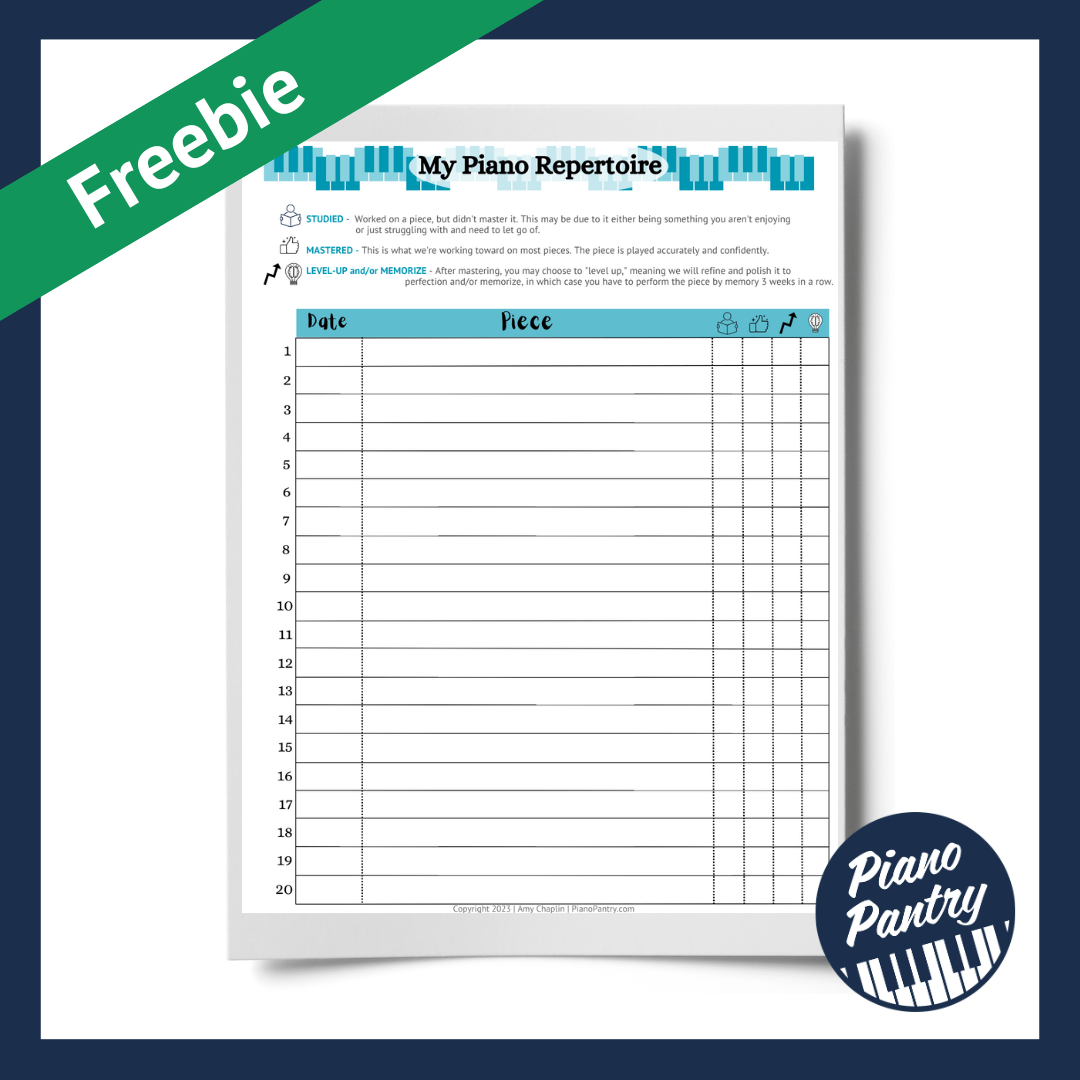
Do you keep track of the pieces your students learn? I’ve done it for as long as I can remember, although I can’t recall what made me get started. There are two reasons one might consider tracking student repertoire.
(1) As time passes, it can be easy to forget the work that students have done. Writing down pieces makes it easy to look back on those accomplishments.
(2) You might need to intentionally track pieces in order to meet specific goals or challenges (such as the 40-piece challenge.)
While this post is not necessarily about the 40-piece challenge, here’s just a brief background if you’re not familiar.
First made popular by Australian-based teacher Elisa Milne, this challenge was ultimately a reaction to piano culture’s highly steeped exams and competitions, where students were only learning a small handful of pieces to perfection each year.
While exam culture is not as prominent in the states, the challenge still gained much attention – and for good reason. Even for students who study higher-level repertoire, the goal is to learn some easier pieces they can learn quickly in order to have exposure to as much repertoire as possible.
I’ve never actually run the challenge formally in my studio, but I do give away an award at my Spring Recital to the student who masters the most pieces. I mainly like to track repertoire so we can remember the work they’ve completed.
Over the years, I’ve used a variety of tracking sheets. In recent years I feel like I’ve refined what works well for me, and I finally feel like I can present you with a sheet I’m proud of that you might also find useful in your own studio.
While there are two parts to this sheet that likely won’t surprise you – “mastered” and “memory,” there are two parts that might have made your head turn – “studied” and “level-up.”
Why “Studied” Pieces?
The goal is ultimately for students to polish their pieces to a solid state, sometimes we start pieces with students and eventually realize we have to let them go. It could be that the student is just struggling to connect with or enjoy the piece or that it’s proving more of a technical challenge than we expected it to be. I’ve learned that – that’s OK! It doesn’t mean that working on the piece was a waste of time – there’s always something we can learn along the way.
As you can imagine, this can happen more frequently with some students than others, so tracking these pieces helps us see the big picture of how much we “let go of” to ensure we don’t see too much of a trend.
Calling it a “study” piece removes the negative connotation that they were not able to master it fully and maximizes the fact that they still benefited from learning and doing some work on the piece.
Why “Level-Up” Pieces?
This particular idea I have to attribute this to my friend, Christina Whitlock, who, in episode 113 of her podcast “To Pass or Not to Pass,” shared the idea of giving students the option to “level up.”
While I use the term “mastered” (unlike her), I’m of the same opinion as her that “mastering” a piece may not necessarily mean it’s polished to “competition-ready” absolute perfection. It might look a little different for each student.
In my early years of teaching – this one was a big struggle – not knowing what “standards” to uphold. Experience has taught me that while generally yes, a nicely played piece should have all the elements – steady beat – appropriate tempo, accurate notes, dynamic contrast, etc., sometimes we have to consider each individual student.
I don’t want to get into too much detail here – I would encourage you to listen to Christina’s episode on the topic. I will say, though, that asking students if they want to “level” up is a good way of knowing how much they love a piece and how determined they are to play it well.
Memory Pieces
Memorizing repertoire is not something I push, but I encourage students to memorize a good handful of pieces each year. This is another area that can be revealing and help you know how much a student loves a piece. They don’t want to memorize something they aren’t enjoying that much.
I tell them that the goal is that they have to play it for me by memory three weeks in a row. (Keep in mind that I’m just talking about general weekly study here—not necessarily what you might need when preparing for a festival, recital, or competition.)
I count the first one as long as it’s “close,” but the second and third ones have to be confidently memorized, or they need to work on them a little longer.
I hope you and your students enjoy using this repertoire list throughout the year!
*By submitting this form, you acknowledge that you’re signing up for my email list and agree to receive regular communication (generally once a week).
08.30.2024 Update
An updated version of this sheet is now available. See this blog post for more details:
